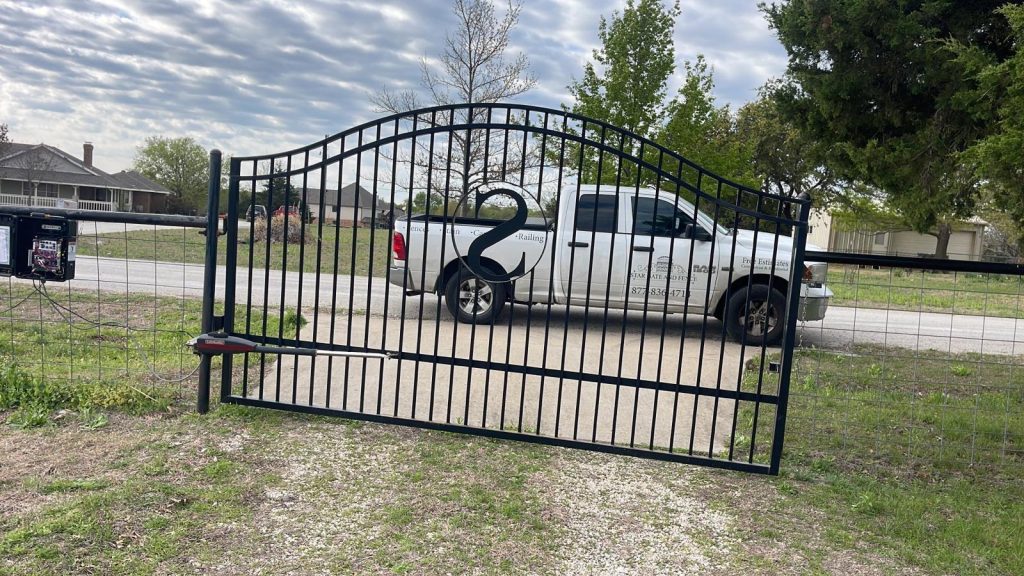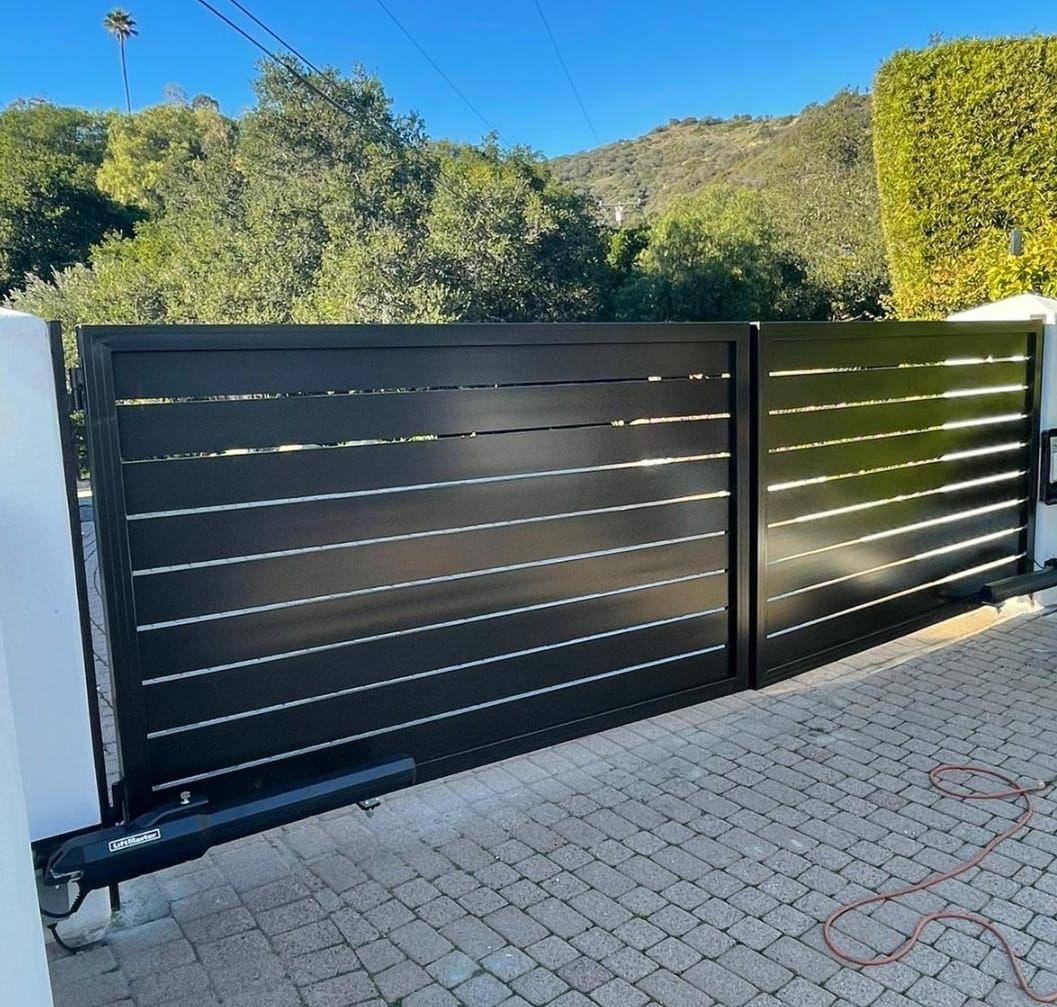When choosing between an automated gate and a manual option, most homeowners focus on three main factors: convenience, security, and cost. Manual options require you to open and close them manually every time. That gets old fast, especially during rainy weather or late-night arrivals. An automated gate lets you control access with a remote or smartphone app. You stay in your car while the system does the work. Sure, the upfront investment is higher, but the daily convenience is worth it. Additionally, modern automation incorporates advanced security features that manual systems cannot match.
How Automated Gate Openers Work
An automated gate opener connects to your existing structure through a motor system. The motor attaches to the frame and moves it along tracks or swings it open. Most systems include a control board that manages the opener’s functions. You activate the opener using a remote, keypad, or smartphone app.
The magic happens when sensors detect your vehicle approaching. Some systems use ground loops buried in your driveway. Others rely on cameras or motion detectors. Once activated, the motor pulls or pushes your entry point smoothly. Safety features stop movement if something blocks the path. This prevents damage to vehicles or injury to people and pets. The whole process takes just seconds from start to finish.

An automatic gate opener refers specifically to the motor component that physically opens and closes your entry point. It’s basically the muscle doing the heavy lifting.
An automated gate system, however, includes the complete setup, which consists of the opener, control boards, safety sensors, remotes, keypads, and access controls.
Think of the opener as one piece of equipment, while the system encompasses everything working together as a whole. When people shop for automation, they’re usually looking for the whole system, not just the opener alone.
The Benefits of Gate Automation for Your Property
Switching to an automated gate brings immediate lifestyle improvements. You never have to leave your car in bad weather. Elderly family members or guests with mobility issues can enter without struggle. The convenience factor alone makes automation attractive for busy families.
Security also receives a significant upgrade. An automated gate stays closed unless you specifically open it. Manual ones often get left open by mistake. Modern systems log every opening and closing. You can track who enters your property and when they do. Many models integrate with home security systems. This creates a complete perimeter defense around your home. Property values increase as well, since buyers love modern security features.
Automated Gate Installation Costs and What to Expect
The cost of installing an automated gate varies based on several factors. A basic system for a single swing setup starts around $1,500 to $3,000. Sliding models for wider driveways run $2,500 to $5,000. Custom fabrication with decorative elements can increase costs. These prices include the operator, control panel, and basic remote access.
Labor costs range from $500 to $1,500, depending on your location. Complex installations, such as those requiring electrical work or concrete, cost more. The good news? Most installations pay for themselves through added home value. Additionally, you avoid the hassle and potential injury associated with manual operation. Think of it as investing in daily convenience and peace of mind.
Gate Installation Process Explained
Professional installation starts with a site assessment. Technicians measure your driveway and check electrical access. They discuss your preferences for swing versus slide operation. Most teams complete basic installations in one day.
First, they mount the motor and control box. Then they run electrical connections to your home’s power. Next, programming the remote controls and safety sensors follows. Finally, they test everything multiple times. Good installers also train you on proper operation and maintenance. The process may seem complicated, but experienced teams make it look effortless.

Understanding Your Automated Gate System Components
Your automated gate system includes several key parts working together:
- Motor operator: The muscle that moves everything
- Control board: The brain manages all functions
- Safety sensors: Stop movement when obstacles appear
- Access controls: Remotes, keypads, or smartphone apps
- Power supply: Usually connects to your home’s electricity
Each component plays a specific role in smooth operation. The operator does the heavy lifting while sensors prevent accidents. Control boards process commands from your remote or app. Understanding these parts helps you maintain the system properly. Quality components from trusted manufacturers tend to last longer and require fewer repairs.
Maintenance and Repair Services You Should Know
Regular maintenance keeps your automated gate running smoothly for years. Most systems need attention twice per year. Technicians lubricate moving parts and check sensor alignment. They also test safety features and adjust operating speeds. This preventive care catches minor issues before they become expensive problems.
When repairs become necessary, call professionals immediately. DIY fixes often cause more damage than they prevent. Everyday repair needs include worn gears, sensor misalignment, and circuit board failures. Experienced technicians diagnose problems quickly and use proper replacement parts. Many companies offer service contracts that include regular maintenance and priority scheduling for repairs. This ensures your system stays reliable when you need it most.
Security Features and Perimeter Protection
Modern automation delivers impressive security benefits for your property. Each system creates a controlled access point at your perimeter. Only individuals with proper authorization are permitted to enter. This prevents unwanted visitors from reaching your home. The psychological deterrent also works, as criminals tend to avoid properties with visible security.
Advanced systems integrate with cameras and intercoms. You can see and speak with visitors before granting access. Some models send alerts to your phone when someone approaches. Activity logs track every opening throughout the day. This data helps identify patterns and potential security concerns. For maximum protection, pair your automated gate with other security measures, such as lighting and cameras.
Long-Lasting Fabrication and Materials
Quality fabrication determines how well your system holds up over time. Steel and aluminum frames resist weather damage better than wood. Powder coating protects metal from rust and corrosion. Heavy-duty hinges and rollers handle thousands of cycles without failing.
The motor and operator should carry strong warranties. Ten years or more indicates quality manufacturing. Cheaper components may save money initially, but they can be more expensive in the long run due to repairs. Look for systems rated for your climate conditions. Coastal areas need extra corrosion protection. Cold climates require motors that operate in freezing temperatures. Investing in quality materials up front saves money and headaches later.
Automatic Gate Opener Vs. Automated Gate System Explained
An automatic gate opener refers specifically to the motor component that physically opens and closes your entry point. It’s basically the muscle doing the heavy lifting.
An automated gate system, however, includes the complete setup, which consists of the opener, control boards, safety sensors, remotes, keypads, and access controls.
Think of the opener as one piece of equipment, while the system encompasses everything working together as a whole. When people shop for automation, they’re usually looking for the whole system, not just the opener alone.
Expert Advice on Making the Right Choice
Here’s what we tell homeowners considering this upgrade. Start by evaluating your daily routine and security needs. If you enter and exit your property multiple times daily, automation makes sense. Families with children or elderly members benefit most from automated gate convenience.
Budget matters, but don’t let it be your only consideration. Inexpensive systems often frustrate owners with frequent repairs and subpar performance. Mid-range options from reputable manufacturers offer the best value. They strike a balance between affordability, reliability, and features. Get quotes from multiple installers before making a decision. Ask about warranties, service availability, and installation timelines. The right system improves your life every single day while protecting your property investment.
FAQ
How long does an automated gate typically last?
With proper maintenance, quality systems last 15-20 years. The motor and operator are the most durable components. Moving parts, such as hinges and wheels, may need replacement every 10-15 years. Regular lubrication and annual inspections significantly extend the lifespan. Harsh weather conditions can reduce the longevity of your equipment, so choose weather-rated components that are suitable for your climate.
Can I add automation to my existing manual gate?
Yes, most manual structures can be automated with the right equipment. A technician assesses your current setup to determine compatibility. They inspect the frame’s strength, weight, and condition. Older or damaged frames may need reinforcement first. The process costs less than installing a completely new system. Most conversions are completed within one day.
What happens if the power goes out?
All quality systems include manual release mechanisms. You pull a cord or lever to disengage the motor. This allows you to open and close everything manually during outages. Some owners add battery backup systems that maintain automatic operation. These batteries kick in immediately when power fails. Solar panel options also provide backup power in sunny climates.
Are automated gates safe for children and pets?
Modern systems include multiple safety features protecting kids and animals. Sensors detect obstacles and immediately stop movement. Pressure-sensitive edges reverse direction if they touch anything. Auto-reverse functions prevent crushing accidents. Proper installation and regular maintenance ensure these features work correctly. Teaching children about safety around automation is still essential.
How much does annual maintenance cost?
Professional maintenance typically costs $150-$300 per year. This includes lubrication, sensor adjustment, and safety testing. Some companies offer service contracts bundling maintenance with priority repairs. These contracts cost $200 to $500 per year, depending on the coverage. DIY maintenance saves money, but it requires knowledge and the proper tools. Most owners find professional service worth the investment for peace of mind.
CAN I CONTROL MY AUTOMATED GATE WITH MY SMARTPHONE ?
Yes, many modern systems offer smartphone integration. You install an app that connects to your control board. This lets you open and close from anywhere with internet access. You can also receive notifications when someone arrives. Grant temporary access to guests or delivery drivers remotely. These innovative features usually add $200-$500 to the system cost.

